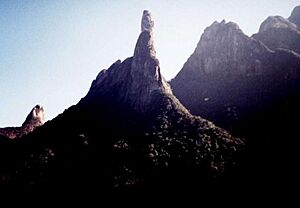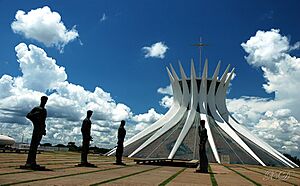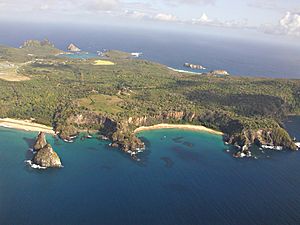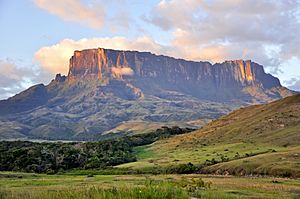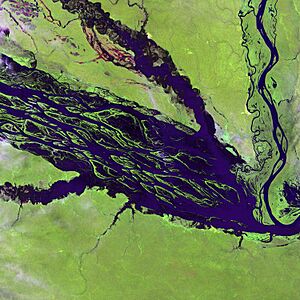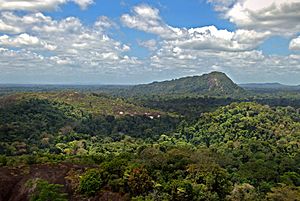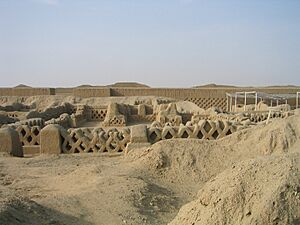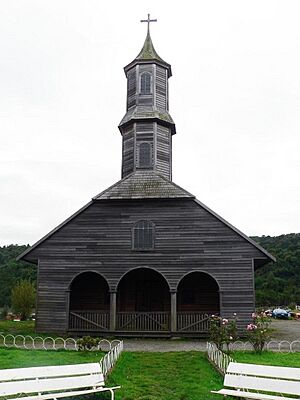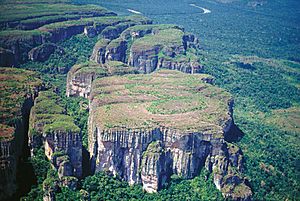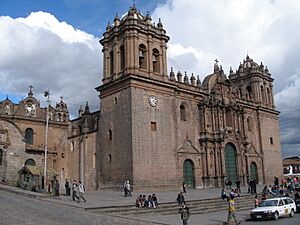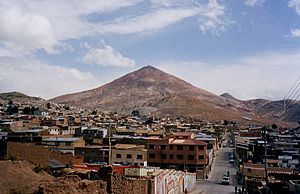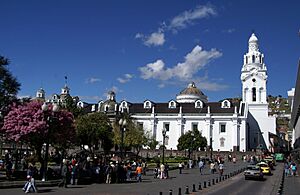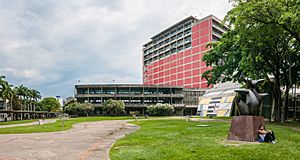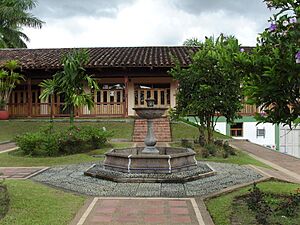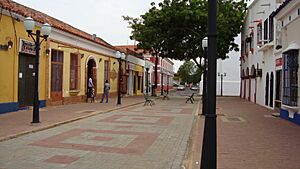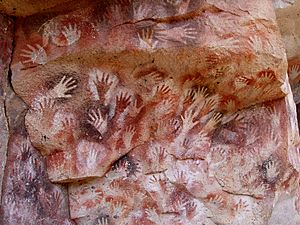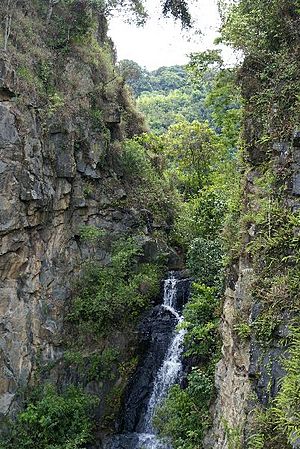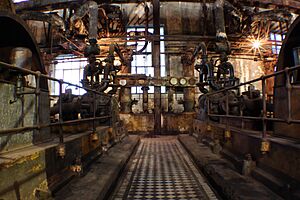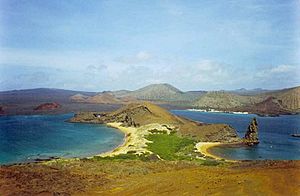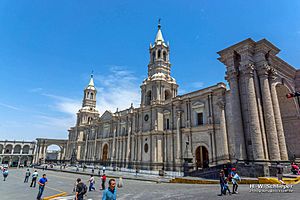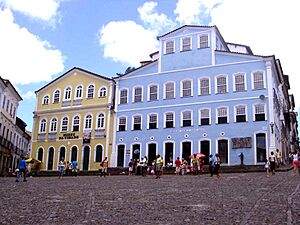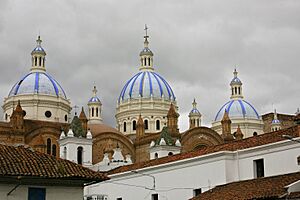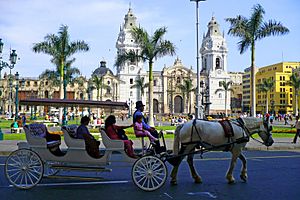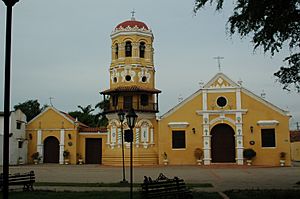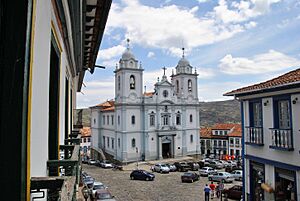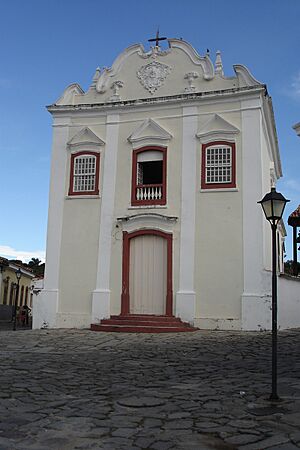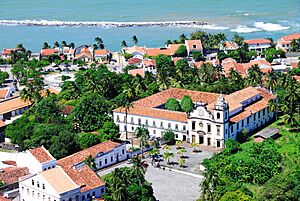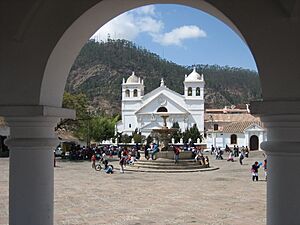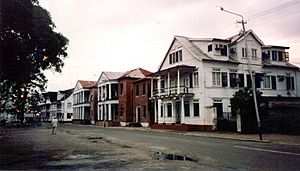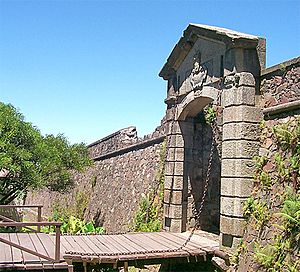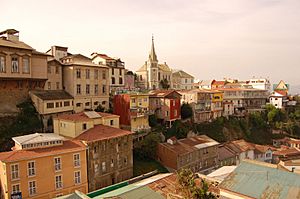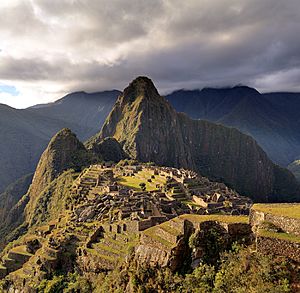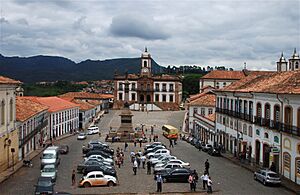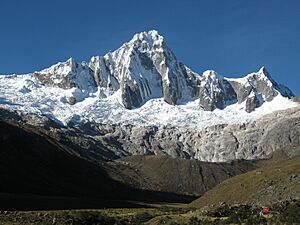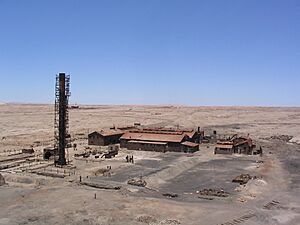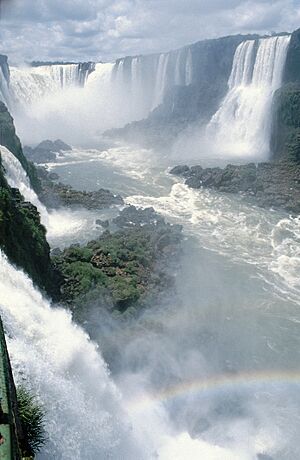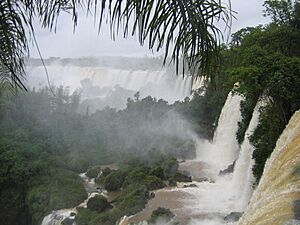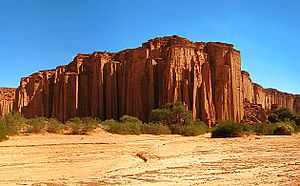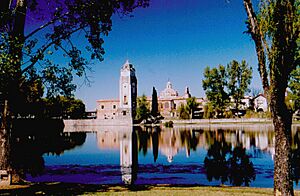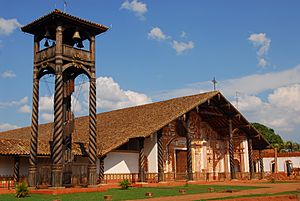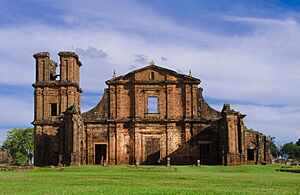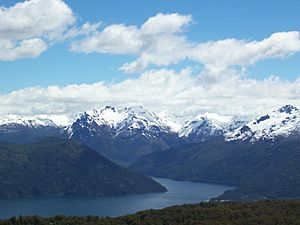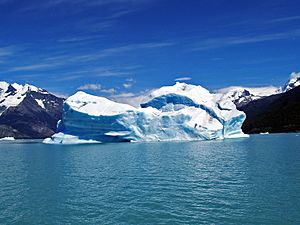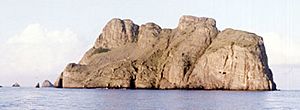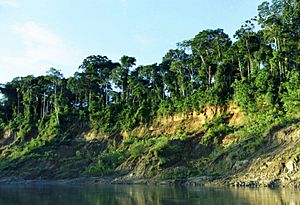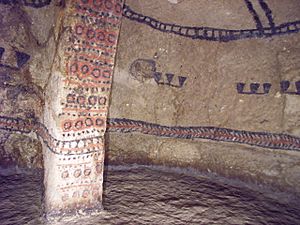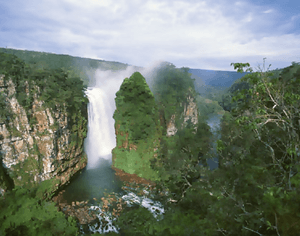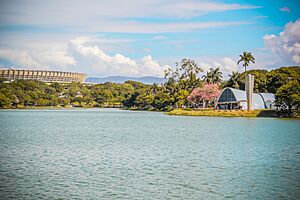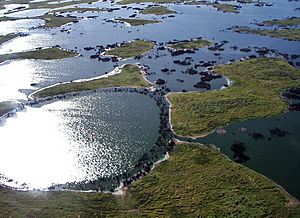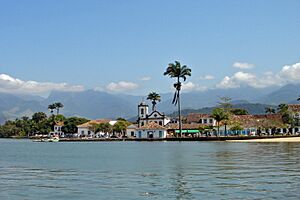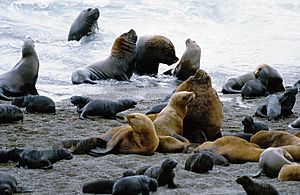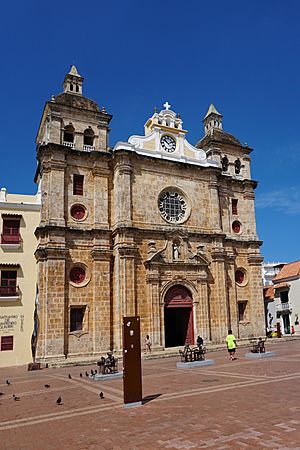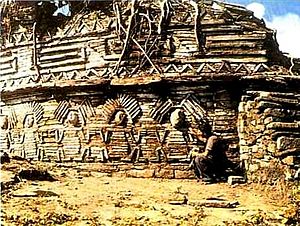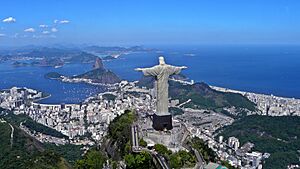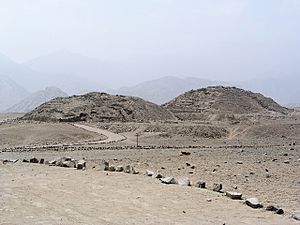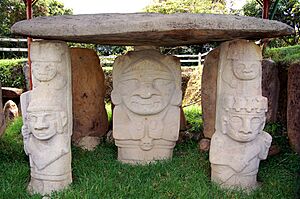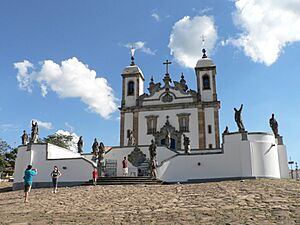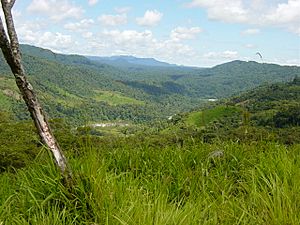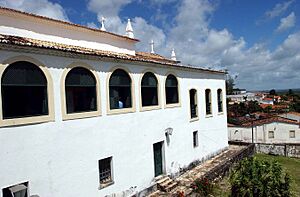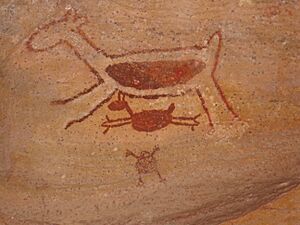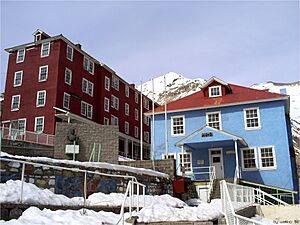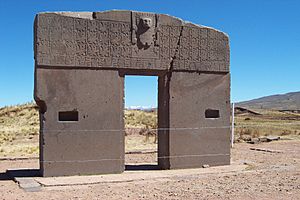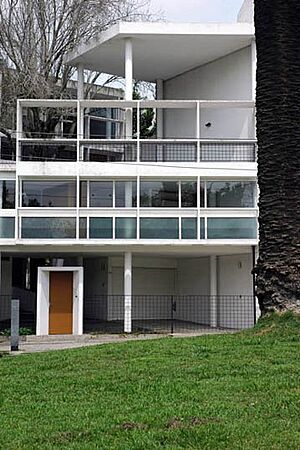List of World Heritage Sites in South America facts for kids
This is a list of amazing places in South America that are so special, UNESCO has named them World Heritage Sites! These sites are important because they have unique natural beauty, incredible history, or show how people lived long ago. They are protected so everyone can learn from and enjoy them for many years to come.
World Heritage Sites
| Site | Image | Location | Year | What Makes It Special |
|---|---|---|---|---|
| Atlantic Forest South-East Reserves | Paraná, São Paulo and Rio de Janeiro states, |
1999 | These reserves protect some of the last remaining parts of the Atlantic Forest. This forest is home to many rare and unique plants and animals, making it very important for scientists and for protecting nature. | |
| Brasília | Federal District, |
1987 | Brasília is a city that was completely planned and built from scratch in 1956 to be Brazil's new capital. It's famous for its unique modern architecture and city design. | |
| Brazilian Atlantic Islands: Fernando de Noronha and Atol das Rocas Reserves | Pernambuco and Rio Grande do Norte, |
2001 | These islands in the South Atlantic are super important for marine life. Many sea creatures, including endangered species like the hawksbill sea turtle, come here to feed and have their babies. | |
| Canaima National Park | Bolívar, |
1994 | This park is famous for its flat-topped mountains called tepui. These mountains cover most of the park and are home to many plants and animals found nowhere else. It also has Angel Falls, the world's highest waterfall! | |
| Central Amazon Conservation Complex | State of Amazonas, |
2000 | This is the biggest protected area in the Amazon basin. It has an amazing variety of plants and animals, including many endangered species. It's a very important place for conservation. | |
| Central Suriname Nature Reserve | Sipaliwini District, |
2000 | This reserve protects a huge, untouched area of tropical forest. It has a high number of different species, including many that are unique to this area or are threatened. | |
| Cerrado Protected Areas: Chapada dos Veadeiros and Emas National Parks | Central Brazil Plateau, State of Goiás, |
2001 | These two parks represent the cerrado, one of the world's oldest tropical ecosystems. It's a vital safe place for many species, especially during times of climate change. | |
| Chan Chan Archaeological Zone | La Libertad, |
1986 | Chan Chan was the capital city of the ancient Chimú culture. It's made of mud-brick buildings. The site was once on the "in danger" list because heavy rain and erosion can easily damage its mud structures. | |
| Chavín (Archaeological Site) | Huari Province, Ancash, |
1985 | This site was the center of the Chavín culture, which lived in the Andes mountains a very long time ago (between 1500 and 300 BC). It has cool terraces and squares carved from rock. | |
| Churches of Chiloé | Chiloé Province, Los Lagos Region, |
2000 | These churches are special because they show a mix of European and local building styles, all made from wood. They were built by Jesuit missionaries in the 17th and 18th centuries. | |
| Chiribiquete National Park– “The Maloca of the Jaguar” | Caquetá and Guaviare Departments, |
2018 | This is Colombia's largest protected area in the Amazon. It has amazing flat-topped mountains called tepuis and over 75,000 ancient rock paintings, some more than 20,000 years old! These paintings show hunting, battles, and ceremonies. | |
| City of Cuzco | Cuzco, |
1983 | Cuzco was the most important city of the Inca Empire in the 15th century. After the Spanish took over, they built their own churches and buildings right on top of the Inca ruins, creating a unique mix of styles. | |
| City of Potosí | Potosí, Potosí Department, |
1987 | Potosí became a huge industrial city in the 16th century after a massive silver reserve was found there. It has old mining facilities and colonial buildings. It was once on the "in danger" list. | |
| City of Quito | Quito, Quito Canton, Pichincha Province, |
1978 | Quito's historic center is one of the best-preserved colonial centers in Latin America. It was built in the Spanish colonial style and was once the capital of a Spanish royal court. | |
| Ciudad Universitaria de Caracas | Municipality of Libertador, Caracas, |
2000 | This university campus is a masterpiece of early 20th-century architecture and city planning. It was designed to be open and airy, perfect for the tropical climate. | |
| Coffee Cultural Landscape of Colombia | Caldas, Quindío and Risaralda Departments, |
2011 | Coffee growing has been a huge part of Colombian culture for over 100 years. It has shaped their music, architecture, food, and education, making it a very special cultural landscape. | |
| Coro and its Port | Falcón, |
1993 | Coro was one of the first colonial towns in the Americas, founded in 1527. Its unique mud buildings mix Caribbean, Spanish, and Dutch styles. It has been on the "in danger" list since 2005 due to rain damage and new buildings. | |
| Cueva de las Manos, Río Pinturas | Santa Cruz Province, |
1999 | This cave is famous for its ancient rock art, especially the paintings of hands. These paintings, made between 13,000 and 9,500 years ago, show us about the very first people who lived in South America. | |
| Discovery Coast Atlantic Forest Reserves | Atlantic Coast, Bahia and Espírito Santo states, |
1999 | Like the South-East Reserves, these areas protect more of the precious Atlantic Forest. They are incredibly diverse, with many rare and unique species, important for both science and nature protection. | |
| Fray Bentos Cultural-Industrial Landscape | Río Negro Department, |
2015 | This site shows an important part of industrial history in South America. It includes old factory buildings and machinery related to meat processing. | |
| Fuerte de Samaipata | Florida Province, Santa Cruz Department, |
1998 | Samaipata has the remains of an old town and a huge sculpted rock from the 14th-16th centuries. It's thought to have been a special ceremonial place for an ancient culture. | |
| Galápagos Islands | Galápagos Province, |
1978 | These remote volcanic islands are super famous because Charles Darwin studied their unique animals, which helped him develop his theory of evolution. Many species here are found nowhere else in the world. The site was on the "in danger" list from 2007-2010. | |
| Historical Centre of the City of Arequipa | Arequipa, |
2000 | Arequipa is built mostly from a white volcanic rock called sillar. The city's architecture mixes traditional local styles with European colonial building methods, creating a beautiful and unique look. | |
| Historic Centre of Salvador de Bahia | Bahia state, |
1985 | This is the old colonial town of Brazil's first capital. It has many colorful Renaissance houses from the 16th to 18th centuries. It was also the site of the first slave market in the New World. | |
| Historic Centre of Santa Ana de los Ríos de Cuenca | Azuay Province, |
1999 | Founded in 1557, Cuenca's city plan shows how different societies and cultures blended together. It's a great example of Renaissance city design in Latin America. | |
| Historic Centre of Lima | Lima Province, |
1988 | Lima was founded in 1535 and was the most important city in Spanish South America for a long time. Its buildings mix local and European styles, like the beautiful Monastery of San Francisco. | |
| Historic Centre of Santa Cruz de Mompox | Bolívar Department, |
1995 | Mompox was founded in 1540 on a major river. Its historic center still looks much like it did in colonial times, with many old buildings still used for their original purpose. | |
| Historic Centre of São Luís | Maranhão state, |
1997 | São Luís has kept its original rectangular town plan and many historic buildings. It's a great example of a Portuguese colonial town. | |
| Historic Centre of the Town of Diamantina | Minas Gerais, |
1999 | This 18th-century colonial town is a well-preserved example of Baroque architecture. It was built in a tough, rocky area and became a big center for diamond mining. | |
| Historic Centre of the Town of Goiás | Goiás, |
2001 | Founded in 1727, Goiás has kept much of its colonial history. It's a good example of a European settlement built deep inside South America. | |
| Historic Centre of the Town of Olinda | Pernambuco, |
1982 | Founded in 1537, Olinda grew rich from sugar cane. After being looted in the 17th century, its historic center was rebuilt in the 18th century, with a beautiful mix of buildings, gardens, and churches. | |
| Historic City of Sucre | Oropeza Province, Chuquisaca Department, |
1991 | Sucre was founded by the Spanish in 1538. It still has many of its 16th-century religious buildings, showing how local and European building styles blended together. | |
| Historic Inner City of Paramaribo | Paramaribo District, |
2002 | Paramaribo was a Dutch colonial town founded in the 17th century. It has kept its unique street plan and buildings that show the influence of Dutch architecture over time. | |
| Historic Quarter of the City of Colonia del Sacramento | Colonia Department, |
1995 | Founded by the Portuguese in 1680, this town changed hands between the Spanish and Portuguese many times. Its well-preserved old town shows a mix of both Spanish and Portuguese colonial styles. | |
| Historic Quarter of the Seaport City of Valparaíso | Valparaíso Province, |
2003 | In the late 1800s, Valparaíso was a busy stop for ships traveling between the Atlantic and Pacific oceans. Its historic quarter, built on steep hills, shows what this important time of global trade was like. | |
| Historic Sanctuary of Machu Picchu | Cuzco, |
1983 | Located high in the mountains, Machu Picchu was a large Inca estate built around the mid-1400s. It has amazing stone walls, terraces, and buildings. About 1,200 people lived here, mostly priests, women, and children. | |
| Historic Town of Ouro Preto | Minas Gerais, |
1980 | This town was very rich during Brazil's 18th-century gold rush. You can see its wealth in the many preserved churches, bridges, and fountains, some designed by the famous artist Aleijadinho. | |
| Huascarán National Park | Ancash, |
1985 | This park is in the Cordillera Blanca mountain range, home to Peru's tallest peak, Huascarán. It has glaciers, deep valleys, and lakes, and is home to several unique animal species. | |
| Humberstone and Santa Laura Saltpeter Works | Tarapacá, |
2005 | These two old saltpeter (a type of salt) factories are in the Atacama Desert. They show what the saltpeter industry was like in northern Chile in the 1800s and early 1900s, which brought people from all over to create a unique culture. The site was on the "in danger" list from 2005 to 2019. | |
| Iguaçu National Park | Paraná, |
1986 | This park protects Iguazu Falls, one of the world's largest waterfalls. It's also home to many rare and endangered animals like the giant anteater and giant otter. It was on the "in danger" list from 1999-2001. | |
| Iguazú National Park | Misiones Province, Mesopotamia |
1984 | This park, along with Iguaçu National Park in Brazil, protects the amazing Iguazu Falls. Its rainforest has over 2,000 plant species and large mammals like tapirs, jaguars, and howler monkeys. | |
| Ischigualasto / Talampaya Natural Parks | San Juan and La Rioja Province |
2000 | This site has the most complete collection of fossils from the Triassic period (245–208 million years ago). The remains of mammals, dinosaurs, and plants here show how vertebrates evolved. | |
| Jesuit Block and Estancias of Córdoba | Córdoba |
2000 | Founded in the early 1600s, this Jesuit site includes a university, church, homes, and five farming estates. They show the important work the Jesuits did for 150 years in the New World. | |
| Jesuit Missions of La Santísima Trinidad de Paraná and Jesús de Tavarangue | 1993 | The ruins of these Jesuit missions show the important religious, social, and economic activities of the Jesuits in the 17th and 18th centuries. | ||
| Jesuit Missions of Chiquitos | Santa Cruz Department, |
1990 | Six settlements in the Chiquitania region are preserved as living examples of Jesuit missions from the 17th and 18th centuries. Their churches mix local and European building styles. | |
| Jesuit Missions of the Guaranis: San Ignacio Miní, Santa Ana, Nuestra Señora de Loreto and Santa María Mayor (Argentina), Ruins of São Miguel das Missões (Brazil) | Misiones Province, |
1983 | These five ruined Jesuit missions were built in the tropical forest where the Guaraní people lived in the 17th and 18th centuries. Each one has a unique design. | |
| Lines and Geoglyphs of Nazca and Pampas de Jumana | Nazca, |
1994 | These huge designs in the Nazca Desert were made by the Nazca culture between 400 and 650 AD. They scratched lines into the ground to create animals, plants, and shapes. They likely had a special religious meaning. | |
| Los Alerces National Park | Chubut Province, |
2017 | This national park protects beautiful forests, lakes, and mountains. It's known for its ancient alerce trees, which are some of the oldest living things on Earth. | |
| Los Glaciares National Park | Santa Cruz Province, |
1981 | This park is incredibly beautiful, with tall mountains, stunning glacial lakes, and huge glaciers, some of which are still growing. | |
| Los Katíos National Park | Antioquia and Chocó Departments, |
1994 | Located in the Darién Gap, this park has hills, forests, and wet plains. It's famous for its amazing variety of plants and animals, including many endangered species. It was on the "in danger" list from 2009 to 2015. | |
| Malpelo Fauna and Flora Sanctuary | Cauca Department, |
2006 | This sanctuary protects Malpelo Island, a unique rock formation in the Pacific Ocean. It's a critical habitat for many marine species, especially sharks and other large ocean creatures. | |
| Manú National Park | Madre de Dios, |
1987 | This park stretches from low-lying areas to high mountains. It's home to an incredible number of species: 1,000 bird species, over 200 mammal species (including 100 types of bats!), and more than 15,000 flowering plants. | |
| National Archeological Park of Tierradentro | Inza, Cauca Department, |
1995 | This park is known for its underground tombs, which are carved into the earth. These tombs have unique designs and paintings, showing the burial customs of an ancient culture. | |
| Noel Kempff Mercado National Park | Santa Cruz Department, |
2000 | This large national park is known for its incredible biodiversity, including different types of forests, savannas, and wetlands. It's a very important place for protecting many species. | |
| Pampulha Modern Ensemble | Belo Horizonte, |
2016 | This site is a collection of modern buildings and landscapes designed by famous architects like Oscar Niemeyer. It's a great example of modern architecture and urban planning from the mid-20th century. | |
| Pantanal Conservation Area | Mato Grosso do Sul and Mato Grosso, |
2000 | The Pantanal is one of the world's largest tropical wetlands. This conservation area protects a huge part of it, which is home to an amazing variety of wildlife, especially birds and aquatic animals. | |
| Paraty and Ilha Grande - Culture and Biodiversity | Rio de Janeiro |
2019 | This special place combines a historic coastal town, Paraty, with beautiful natural areas of the Atlantic Forest. It's home to many threatened animals like the jaguar and woolly spider monkey. Paraty was once a key port for shipping gold to Europe. | |
| Península Valdés | Viedma Department |
1999 | This peninsula is a very important place for marine mammals. You can see many different species here, including whales, sea lions, and elephant seals, especially during their breeding seasons. | |
| Port, Fortresses and Group of Monuments, Cartagena | Bolívar Department, |
1984 | Cartagena was a very important port city during colonial times. It has strong fortresses and beautiful old buildings that show its rich history and how it was protected from attacks. | |
| Quebrada de Humahuaca | Jujuy Province |
2003 | This valley has been a major trade route for 10,000 years. It shows how people have lived and traveled through the Andes mountains for centuries, with evidence of ancient cultures and colonial towns. | |
| Qhapaq Ñan, Andean Road System | 2014 | This is a huge network of roads built by the Inca Empire over many centuries, covering 30,000 kilometers! It connected the high Andes mountains to the coast, going through all kinds of landscapes. | ||
| Rio Abiseo National Park | San Martín, |
1990 | This park protects a rainforest habitat and is home to many unique species, like the yellow-tailed woolly monkey, which was once thought to be extinct. It also has over 30 ancient sites from before Columbus arrived. | |
| Rio de Janeiro: Carioca Landscapes Between the Mountain and the Sea | Rio de Janeiro, |
2012 | This site celebrates the unique way Rio de Janeiro's city life blends with its stunning natural surroundings. It includes famous spots like Tijuca National Park, Corcovado Mountain with the Christ statue, and the beautiful beaches of Copacabana. | |
| Sacred City of Caral-Supe | Lima, |
2009 | Caral is one of the oldest known cities in the Americas, dating back to the Late Archaic period. It has many monuments and pyramids, showing how complex urban life was in this region thousands of years ago. | |
| San Agustín Archaeological Park | San Augustin and San José de Isnos, Huila Department, |
1995 | This park is famous for its large collection of ancient stone statues and tombs. These sculptures were created by a mysterious culture that lived here long before the Spanish arrived. | |
| Sanctuary of Bom Jesus do Congonhas | Congonhas, Minas Gerais, |
1985 | This beautiful sanctuary is a great example of Brazilian Baroque art. It features impressive sculptures by the famous artist Aleijadinho, especially his statues of prophets. | |
| Sangay National Park | Morona Santiago, Chimborazo and Tungurahua Provinces, |
1983 | This park has a wide range of ecosystems, from tropical rainforests to glaciers. It's home to many unique and endangered species. It was on the "in danger" list from 1992-2005. | |
| São Francisco Square in the Town of São Cristóvão | São Cristóvão, Sergipe, |
2010 | This square is a well-preserved example of a Franciscan convent complex from the colonial period. It shows the religious and architectural styles of the time in Brazil. | |
| Serra da Capivara National Park | Piauí, |
1991 | This park is famous for its many rock shelters with ancient cave paintings. These paintings are some of the oldest in the Americas, showing the lives of early human inhabitants. | |
| Sewell Mining Town | Machalí, Cachapoal Province, O'Higgins Region |
2006 | Sewell is an old mining town built on a steep hillside in the Andes. It was created for copper mining and is a unique example of a company town designed for its challenging mountain environment. | |
| Tiahuanacu: Spiritual and Political Centre of the Tiahuanacu Culture | Ingavi Province, La Paz Department, |
2000 | Tiahuanacu was the center of a powerful pre-Inca civilization that flourished for centuries. It has impressive stone structures, including temples and monuments, showing the advanced skills of this ancient culture. | |
| The Architectural Work of Le Corbusier, an Outstanding Contribution to the Modern Movement | 2016 | This site includes a building in Argentina that is part of a larger collection of works by the famous architect Le Corbusier. His designs were very important in shaping modern architecture around the world. | ||
| Valongo Wharf Archaeological Site | Rio de Janeiro, |
2017 | This archaeological site is the remains of an old stone wharf where enslaved Africans arrived in Brazil. It's a powerful reminder of the history of slavery and its impact. |
See also

All content from Kiddle encyclopedia articles (including the article images and facts) can be freely used under Attribution-ShareAlike license, unless stated otherwise. Cite this article:
List of World Heritage Sites in South America Facts for Kids. Kiddle Encyclopedia.

